“Pride and Prejudice” – a Film Romance or a Story of Female Courage?
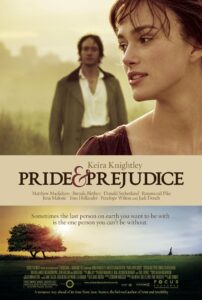
Title: “Pride and Prejudice”
Release Date: 2005
Director: Joe Wright
Cast: Keira Knightley, Matthew Macfadyen, Donald Sutherland, Brenda Blethyn, Rosamund Pike, Jena Malone, Simon Woods
Jane Austen’s “Pride and Prejudice” enjoys a special love of cinema. For it is the prototype for romantic comedies – firstly, about a beautiful girl who is rescued from poverty by a wealthy prince, like Pretty Woman. But it is also a model of a story about a brave single woman who refuses to make compromises in love, like “Bridget Jones’s Diary”. The film adaptation of Joe Wright’s novel is an attempt to return to the fictional source so eagerly exploited by popular cinema.
“Pride and Prejudice” – naturalism and realism instead of romanticism
“Pride and Prejudice” has been translated into film several times. The most famous adaptations include the 1940 version directed by Robert Z. Leonard and starring Greer Garson and Laurence Olivier, and the popular 1995 BBC series starring Jennifer Ehle and Colin Firth. Both were very different – the first set in the atmosphere of nostalgia for the pre-war idyllic world, the second used feminist themes. Joe Wright’s film, on the other hand, was inspired by the idea of rendering the spirit of Jane Austen’s novel as faithfully as possible. It has to be said that in many aspects this intention was successful, especially when it comes to the realism of the picture and the anti-romantic edge of the story, which although not as clear as in the novel by the English writer, is strongly hinted at.
“Pride and Prejudice” tells the story of Elizabeth Bennet, one of five daughters of a not very wealthy family living in Netherfield. When the wealthy Mr. Bingley and his friend Mr. Darcy arrive, Mrs. Bennet, the girls’ mother, begins to hope that one of her daughters will win the heart of the noble bachelor. Soon there is a ball, where the most beautiful of the ladies – Jane really charms the newcomer. Elizabeth, on the other hand, does not like the proud aristocrat, Mr. Darcy at all, and soon after the information about his wicked deeds, she begins to develop a great antipathy towards him. However, fate continually intertwines the paths of the feisty Lizzie and the English gentleman, who, contrary to his social standing and his own ideas, falls head over heels in love with the original girl. In the end, despite numerous obstacles, both couples make a happy marriage.
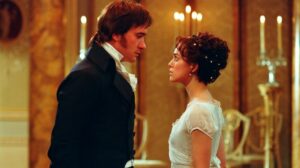
Joe Wright’s “Pride and Prejudice” is notable primarily for its efforts to faithfully read Jane Austen’s novel. The director completely forgoes the candy-coated staffage that characterizes traditional 19th century romances. This is already visible on the visual level of the film – the idyllic frames, straight out of the paintings of the era, are replaced by realism and even naturalism. The Bennet household is not so much a charming little manor house where the girls spend their days reading and embroidering, but a building often shown from the backyard, where we see geese, cows and pigs. Particularly telling is the scene of Lizzy swinging on a swing, reminiscent of Fragonard’s famous painting. However, while the Rococo painter’s painting is a colorful, carefree setting, the film’s heroine is faced with a down-to-earth view of a muddy farm.
“Pride and Prejudice” – women’s courage versus patriarchy
The mentioned swing, but also, for example, the opening sequence of images, in which we see Lizzy returning from her morning walk with a book in her hand, emphasize the heroine’s isolation from the gloomy world and her constant “rocking”. Elizabeth clearly does not want to give in to the hard determinism of her fate, and yet as one of the five daughters of a not very wealthy family, she has poor prospects for the future. The lack of a male heir, due to the inheritance laws in force in eighteenth-century England, means that the entire family fortune will go to a distant relative upon her father’s death, leaving the women at his mercy.
The only way for the heroine to secure her future in such a world is to get married. Despite this, Lizzy has no intention of doing anything against herself – nor of accepting the proposal of her complacent and selfish relative, Mr. Collins. Furthermore, she also rejects the marriage proposal made by the great magnate, Mr. Darcy. The contemptuous way he speaks of her family and his sense of superiority do not allow the girl to consider him as a candidate for her husband. This attitude makes the heroine an exceptional person who, despite the social conventions of her gender and low social status, has the courage to save face and dignity. These values are much more important to her than a comfortable life with even the most wealthy but morally dubious spouse.
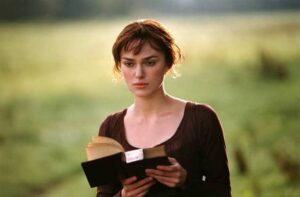
The movie “Pride and Prejudice” ingeniously emphasizes these qualities of Lizzy in the symbolic layer. The most eloquent sign of approval of the girl’s steadfast attitude is the twice-repeated motif of the handkerchief. When a military garrison arrives in town, Lizzy loses her white handkerchief, which is then picked up by Mr. Wickham, who raises it to his lips in an impassioned manner. A similar situation happens to Lydia, where Elizabeth’s younger sister purposely throws her handkerchief under the feet of marching soldiers, but the material is trampled by them. Lizzy and Lydia embody two radically different attitudes toward wealth and marriage. Lydia is an example of an empty-headed bumbling woman ruthlessly hunting for a wealthy husband. Ultimately, her actions when she secretly runs off with Wickam nearly bring the entire family into disrepute. The unworthy bachelor marries her only thanks to a considerable sum offered by Darcy. Meanwhile, Lizzie’s attitude is “rewarded”, even though she does not seek splendor, her fate follows the pattern of the story of Cinderella marrying Prince Charming.
“Pride and Prejudice” – a woman’s perspective of the world
“Pride and Prejudice” is a film in which the world is shown from the point of view of the female protagonist, and this subjective, female perspective, in keeping with the spirit of Jane Austen’s prose, makes the whole thing very interesting. The opening scene of the film shows that we see the world through the eyes of Liza Bennet, the camera seems to be placed in the protagonist’s eye – we see her feet, and we also look into the book she is reading. Only then does a slightly broader perspective appear, which, however, does not weaken the film’s subjective narrative. The window motif, for example, is significant. It is also introduced at the beginning of the film when Elizabeth enters the house and through the window sees her parents having a funny conversation.
The portrayal of the Bennet family from Lizzy’s point of view does not diminish their flaws, on the contrary, it shows them with redoubled force – the girl as a member of the family knows best the weaknesses of the household. The film shows Mrs. Bennet’s greed and uneducatedness, Elizabeth’s younger sisters’ laziness and crankiness, and her father’s neglectful upbringing. At the same time, however, these flaws are mitigated in the film thanks to Lizzy, to the clear benefit of the whole. While in Jane Austen’s prose mothers are usually negative figures, in Wright’s version Mrs. Bennet’s character not only stands up for her own comedy, but also for realism. She is, after all, the parent of five daughters, and she has to be extremely cautious to keep them out of poverty. Hence, Mrs. Bennet’s grotesque efforts have another, sadder side.
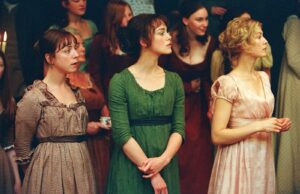
The plight of the poor woman in society is best illustrated by the situation of Liza’s friend Charlotte. At first, Charlotte makes fun of Mr. Collins’ advances to Elizabeth, but later she accepts his proposal. The scene in which she personally explains to her friend the reasons for her decision is one of the most moving in the film. Charlotte says that she is already 27 years old and a burden to her family, and that marriage can provide her with security and a home of her own. The force of these arguments shocks Lizzy, and it is only from this moment that the heroine’s maturation process begins.
“Pride and Prejudice” – the modern and boring Mr. Darcy
“Pride and Prejudice” is a film that also portrays men, especially Mr. Darcy, from Lizzy’s point of view. So while he is initially meant to arouse antipathy in the viewer – just as he does in the heroine – he then begins to gain, eventually becoming a passionate object of love. It has to be said, however, that at this point the filmmakers did not quite follow the spirit of Jane Austen, which may result from a lack of ideas for the character of Darcy.
Of course, it’s not easy to play Mr. Darcy after the iconic performance created by Colin Firth in the iconic British series, but the accusations against Matthew Macfadyen’s role have merit. In the novel, Lizzy does indeed change her attitude towards the aristocrat, but she does so primarily under the influence of his own transformation. In the film, on the other hand, Darcy is completely static, with a single face that does not seem to reflect his pride, but rather his inner problems with expressing his feelings.
The film’s Darcy is a modern man completely lost in a world with very conflicting expectations of him. Open emotionality and sensitivity are traits that have been demanded of men by the intense changes in morality, requiring them to be both a steadfast protector and a tender listener to the female heart. As a result, Mr. Darcy is an internally blocked frustrate who dreams that Miss Bennet will “open” him to people.
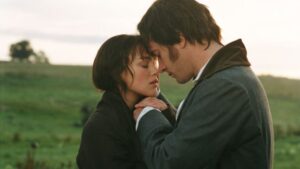
How strongly he hides his feelings is evidenced by the leitmotiv of the character’s hand. A close-up of his hand appears three times in the painting, and each time at a significant moment. The first time we see it is when he helps Lizzy into the carriage – it is their first physical contact, which makes a huge impression on the man. As Darcy walks away, he nervously straightens his fingers, as if life has suddenly entered his stiff body. The second time Darcy shakes Lizzy’s hand is when she and her uncle visit the hero’s stately estate. When Elizabeth departs, the man’s hand remains motionless and alone – as does Darcy himself, who has no hope of a relationship with the woman with whom he has fallen in love.
The last time the man’s hand appears is in the final, very significant scene – Darcy shakes Liza’s hand, and the woman finds it very cool and brings it closer to her lips. The importance of this kiss is emphasized by the fact that there is no shot of the lips touching. This is a telling reversal of traditional roles – clearly it is the woman who takes the initiative here, she becomes the man’s guide in the world of feelings. She is also the one who is not only chosen, but makes the choice herself and finds fulfillment in it.
“Pride and Prejudice” – anti-romance
Keira Knightley’s portrayal in “Pride and Prejudice” has also been modernized, especially through the lens of feminism, but it can be said to have had a satisfactory effect. It is not difficult to see in Liza the traits that herald the emergence of a completely new cultural model of a woman – courageous, active, independent in her thinking, though still limited by social patterns. Knightley’s behavior is, of course, much freer than what a woman could afford at the turn of the eighteenth and nineteenth centuries. This is particularly evident during the ball scene, when the heroine herself openly asks Darcy “if he won’t dance.” Although the girl is rejected by her partner, the initiative is clearly in her hands.
Keira is stunningly beautiful, but her beauty is somewhat muted by her extremely modest clothes and unkempt hairstyle, which takes away from her romantic heroine qualities. In the foreground is her ordinariness and not at all easy character. Lizzy is a girl who can be mischievous and bitingly ironic, which makes her stand out from the rest of the well-behaved ladies. Nevertheless, at times she seems too childish, which is not quite in line with the original character. In the case of the novel Lizzy’s sharp tongue and keen mind are not an expression of childish cheerfulness, but her only weapon against the hard rules of the world in which she lives.
In the end, however, the filmmakers managed to retain much of the spirit of Jane Austen’s prose. They abandoned romanticism, signaled the difficult position of women in the society of the time and showed the social dimension of marriage. It is also one of the few screen adaptations of books by an English writer that does not end with a wedding scene. It could not be avoided even in Ang Lee’s great “Sense and Sensibility”. Joe Wright did not show the wedding scene of Elizabeth with Mr. Darcy and her sister Jane with Mr. Bingley, just as Jane Austen marginally treated this event in the finale of the novel. It is true that she mentions the wedding, but only briefly. She repeats this treatment in each of her novels, which makes her works anti-romance and directs the reader to the social rather than the romantic dimension of love.
